Table of Contents
Hi learners! Want to acquire Java full stack skills and are looking for a Full Stack Developer Roadmap 2024? That’s a wonderful thing. Full Stack Developer being the mastermind of the website is day-by-day becoming one of the super powerful niches in the tech world.
If you are also in the queue to build some amazing things and start with this awesome journey, you have landed on the right spot. In this instant Skilcamp guide, we will be covering all your queries like –
- Showcasing a complete roadmap to become a full stack developer
- Where to find full stack developer intern jobs?
- Where to find the full stack developer course near me?
- What are the best programming languages for Full Stack Development?
- Where can I find Java Full Stack Developer jobs?
Covering every detail that will let you build your own websites, fix stuff, and become a web-making hero. So, don’t miss out on this grand opportunity. Seize it and get ready to code your way to the top!
Who is a Full Stack Developer and What Does a Full Stack Developer Do?
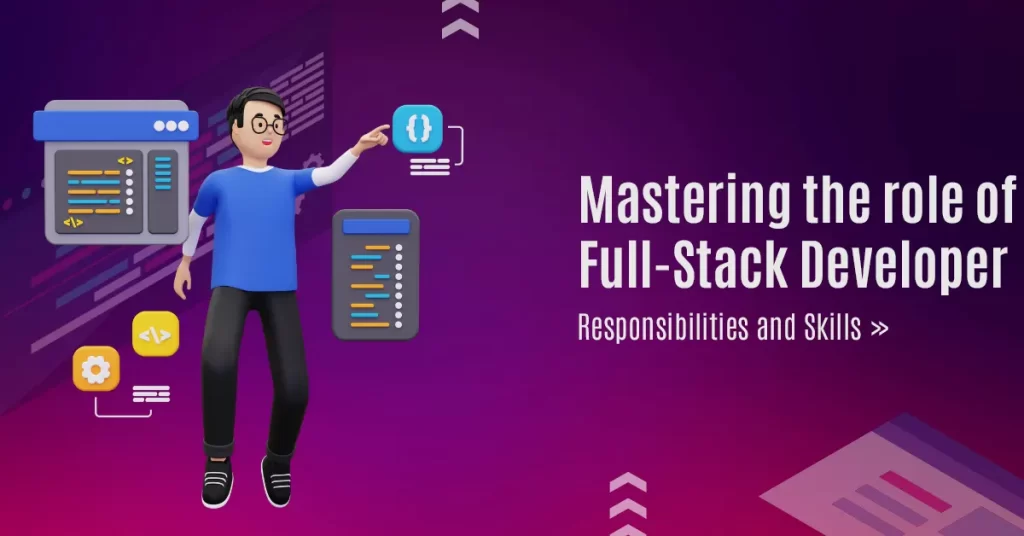
For someone who doesn’t know what Full Stack Developer stands for? Then let us tell you, have you ever wondered how some of your favourite websites work? If not, then you will be astonished to hear that those pretty and complex pages you view are created by one and only Full Stack Developer.
These tech experts hold some unique ability to navigate both the front-end and the back-end of a website, making them true superheroes in the tech realm. Some of the major roles played by the Full Stack Developer are –
- To create user experiences
- To create and manage technology
- To create continuous improvements
- To create a growth strategy
- To create awareness of new tools
- To create the software from ideas
- To test, troubleshoot, debug, and upgrade software applications
- To create effective team dynamics
Is It Worth Learning Full-Stack Developer in 2024?
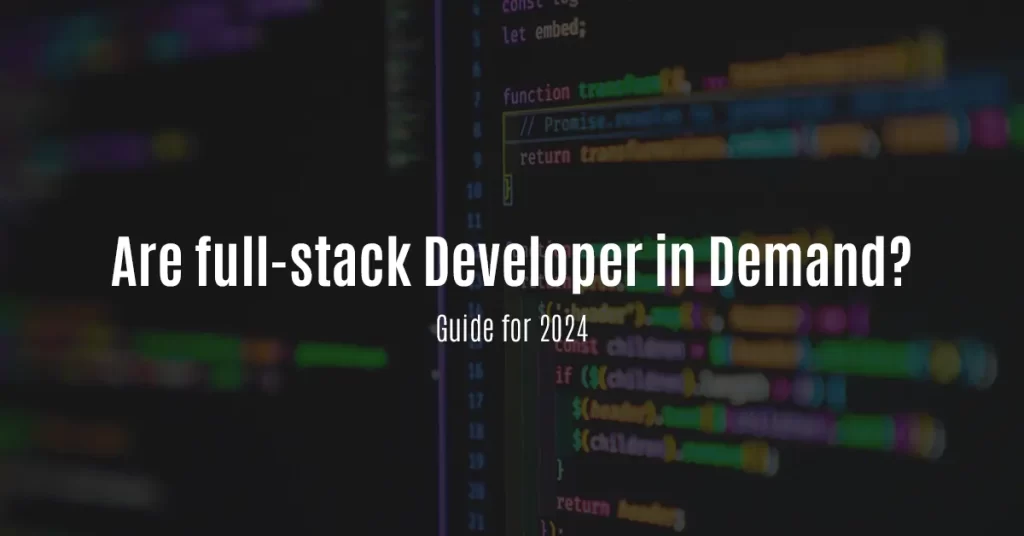
Before you unlock the roadmap, let us ask you one thing: Do you also ask yourself – is becoming a full-stack developer a right choice? If yes, then don’t hide, freely express yourself. Addressing this major issue is prime, isn’t it?
To be honest, the job market for web developers is booming and is expected to hike up to 13% by the year 2026. Moreover, full-stack developers are seeking to become more sought after. Businesses now need experts who can understand their entire tech landscape.
So, with tech evolving rapidly, the demand for full-stack talent far outpaces supply. For those eyeing a career with high potential, full-stack development is a great choice. Let us check out the current salary package of full-stack developers based on location as per Simplilearn’s findings.
- United States: Average salary is $106,148.
- India: Starting at ₹375,000, with mid-level salaries around ₹12-14 lakhs.
- Germany: €57,335 per year.
- Canada: Around $83,210 annually
Also, remote opportunities are on the rise, making this career path even more attractive. Want to build promising growth with flexibility? Becoming a full-stack developer is the perfect choice.
Perquisites For Becoming A Full Stack Developer in 2024
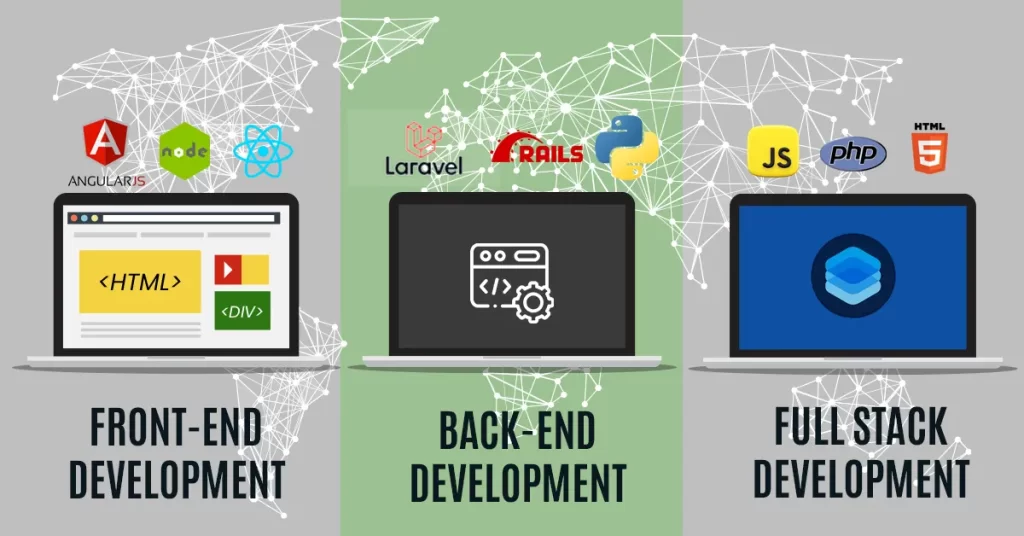
Now, to delve deeper into the Full Stack Developer roadmap 2024, you need to first understand the main perquisites essential for entering the web development game. As already said, a full stack developer covers everything. Below you will find the 3 core elements for becoming a good full-stack developer.
- Front-End Development
The first core element on the roadmap for full stack developers is the knowledge of Front-end Development. Under this, the developers build the interface of a web application where users can interact. Some of the key front-end technologies include:
- HTML/CSS: HTML refers to the structuring of web pages, while CSS usually styles the web pages.
- JavaScript: It adds interactivity and dynamic features to websites.
- Frameworks: It involves tools like React, Vue, and Angular that simplify building complex user interfaces.
- Back-End Development
The second core element on the list is the Back-end Development. Under this, the developer creates the server side of a web application that manages application logic and interacts with the database. Some of the key back-end technologies include:
- Frameworks: It involves tools such as Node.js, Laravel, and Django that help in developing the backend of web applications.
- Application Programming Interfaces (API): This enables communication between the server and client sides of an application.
- Database Development
The third core element is Database Development. This involves the usage of tools for storing and managing a web application’s data. Some key database technologies include:
- Relational Databases: It includes tools like MySQL, PostgreSQL, and Oracle to help manage structured data.
- NoSQL Databases: It includes MongoDB and Cassandra for handling unstructured or semi-structured data.
- Object-Relational Mapping (ORM): Usage of tools like Hibernate and Sequelize to facilitate the mapping of data between the database and the application.
That’s it! Let us take a look at the step-by-step guide to becoming a proficient developer.
Full Stack Developer Roadmap 2024: Step-by-step Guide
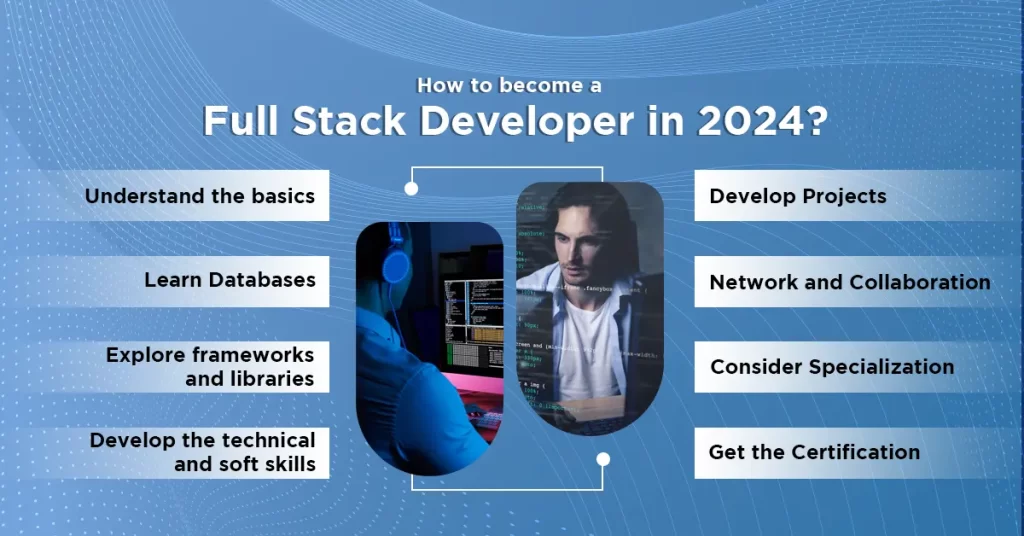
- Begin With Right Education
The first step on the list of the complete roadmap for full stack developers is to start with solid education. There are different paths to start with like –
- Foundational Knowledge
The first one is through foundational knowledge. Before diving into the degree or program, try to familiarize yourself with basic computer skills, design principles, introductory HTML and CSS, and Java full stack skills.
- Formal Education
The next way is through a formal education. You can enroll in a university degree with a major in computer science.
- Online Courses
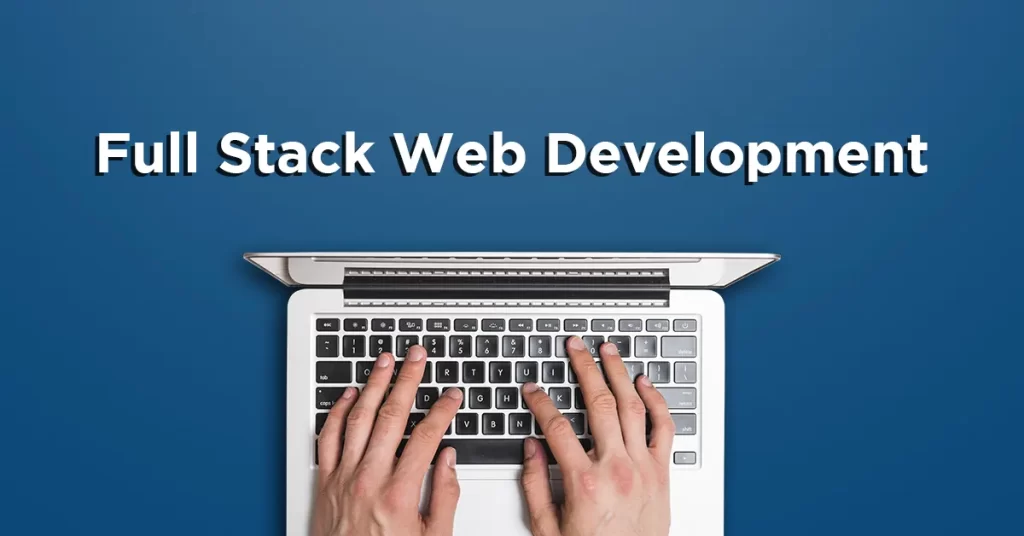
The third way to start is by registering for the online courses. If you are thinking about where to find the full stack developer course near me, then Skilcamp offers a complete Full Stack Developer course.
Whether you are a beginner or an Intermediate, you will find both the courses that will make you job-ready, offering a job placement guarantee. This is one of the quicker and most affordable ways.
- Self-Taught Route
The fourth way to start is through self-taught routes. Ideal for those who prefer a flexible pace. For this, you can utilize resources like YouTube tutorials and study real code on GitHub.
- Master Programming Languages and Tools
The next step on the list of Full Stack Developer roadmap 2024 is to master the right languages and tools. For programming languages, you can work on JavaScript at first and then start with
React, Node, Python, PHP, and C#.
Once you are comfortable with the programming language, get started with other essential tools such as text editors like Visual Studio Code, terminals for running code, databases for storage, and version control tools like GitHub.
- Keep Sharpening Your Skills
The third step on the list of the complete roadmap for full stack developers is to keep sharpening your skills. Learning doesn’t stop by just completing the course. You need to always keep learning and sharpen your soft and technical skills.
- Technical Skills: Learn JavaScript tools like NodeJS and ExpressJS, and get acquainted with the use of web hosting platforms like AWS and Heroku.
- Soft Skills: Boost your soft skills like clear communication, being flexible when switching between front-end and back-end work, and managing projects efficiently as you grow in your career.
- Establish a GitHub Presence
The fourth step on the list of a roadmap for full stack developers is to establish a GitHub presence. A GitHub profile is essential for showcasing your work, connecting with other developers, and sharing code files. It’s a must-have for professional developers in 2024 to get the first preference during the hiring process.
- Find Guidance from a Mentor
The fifth step on the list of roadmap for full stack developers is to find the right guidance from the mentor. This is one of the most underrated steps. But, trust us, a mentor can provide guidance and help you navigate challenges, ensuring you crack a good internship or developer job.
- Polish Your Resume
The sixth step on the list is to continuously polish your resume. Now, after you’ve completed an internship and worked on some projects, it’s time to start looking for jobs. Start applying for the right roles and keep on updating your resume based on the description of each job. This will show the recruiters that you’re serious about the role.
Following this route will surely help you build a bright career in web development. Below we have shared a few key tips to take you one step closer to skyrocketing your journey.
Bonus Tips for Future-Proofing Your Full Stack Developer Career
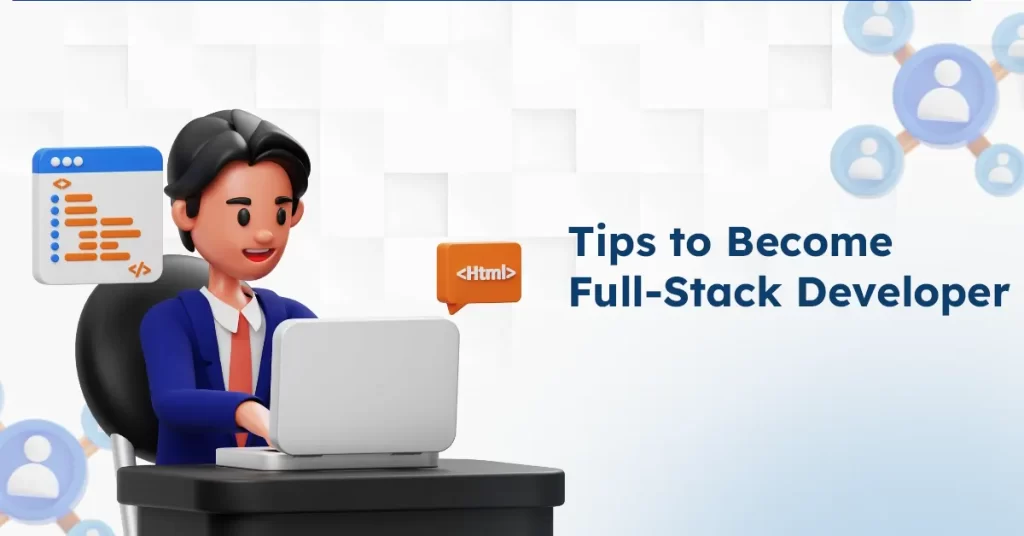
- Staying Ahead of the Curve
The first bonus tip on the list of Full Stack Developer Roadmap 2024 is to stay current with new trends and technologies. The tech world is always changing, so it’s important to keep learning about the latest tools and ideas. Focus on reading tech blogs, attend web development conferences, and enroll yourself in a Full Stack Developer online course to build your skills.
- Acquaint Yourself With Stack Questions
Do you know what are the most common Java Full Stack Developer interview questions? If not, then the second bonus tip is to acquaint yourself with the most popular and general question. For instance –
- What programming languages are you currently using?
- How do you stay updated on new technologies and tools?
- What has been the most challenging coding problem you’ve faced?
- Do you hold any technical certifications?
- In your opinion, what is the most important character trait for a full stack developer?
- What is your experience with Java frameworks such as Spring or Hibernate?
- What can you tell me about front-end technologies like HTML, CSS, and JavaScript?
- Build Valuable Connection
The third bonus tip on the list is to build valuable connections with people in the tech industry. For this, consider going on meetups, joining online communities, and participating in open-source projects. Networking can greatly lead to job opportunities and help you create valuable relationships in the field.
Ending Note
The landscape of full-stack development in 2024 is vibrant and filled with opportunities. The tech world is waiting for innovative thinkers and problem-solvers like you to build the next generation of digital experiences.
So, are you ready to kickstart your journey? Join Skilcamp’s Full-Stack Developer Course For beginners or Intermediate to gain insights needed to excel in this dynamic field. Click here to sign up now! Start shaping the future of technology today!
FAQs
1. What skills do I need to become a Full Stack Developer?
Ans. To become a Full Stack Developer, you need a mix of front-end and back-end skills. This includes proficiency in HTML, CSS, JavaScript, and the knowledge of frameworks like React or Angular for front-end development. While on the back end, you will need familiarity with programming languages such as Node.js, Python, or Java.
However, understanding databases like MySQL or MongoDB, version control systems like Git, and basic server management is also important.
2. What are the best programming languages for Full Stack Development?
Ans. The best programming languages for Full Stack Development include JavaScript for front-end development and Node.js for back-end development. Additionally, languages like Python, Ruby, and Java are valuable for server-side programming.
3. How long does it take to become a Full Stack Developer?
Ans. The time it takes to become a Full Stack Developer varies depending on your background and the learning path you choose. If you study full-time, you can become proficient in about 3 to 6 months. If you learn part-time or through self-study, it may take 6 months to a year or more to build a solid skill set.
4. Is a degree necessary to become a Full Stack Developer?
Ans. A degree is not strictly necessary to become a Full Stack Developer. Many successful developers are self-taught or have completed coding boot camps instead of formal degrees. What matters most is your ability to demonstrate your skills through a strong portfolio and practical experience.
5. What tools and frameworks should I learn?
Ans. You should learn essential tools and frameworks such as React, Angular, or Vue.js for front-end development and Express.js or Django for back-end development. Also, familiarity with Git for version control can be an advantage, along with knowledge of database management tools like MySQL or MongoDB.
6. Where can I find Java Full Stack Developer jobs?
Ans. You can find Java Full Stack Developer jobs on job boards like LinkedIn, Indeed, Glassdoor, and Monster. Websites like Stack Overflow Jobs and GitHub Jobs also list tech openings. Additionally, networking on LinkedIn and attending local tech meetups can help you discover great opportunities.
7. Where to find full stack developer intern jobs?
Ans. You can find full stack developer intern jobs on platforms like LinkedIn, Indeed, Glassdoor, and Internshala. You can also browse the career pages of tech companies you’re interested in for listings. Further, you can reach out to your college’s career center for resources and support in finding internships.

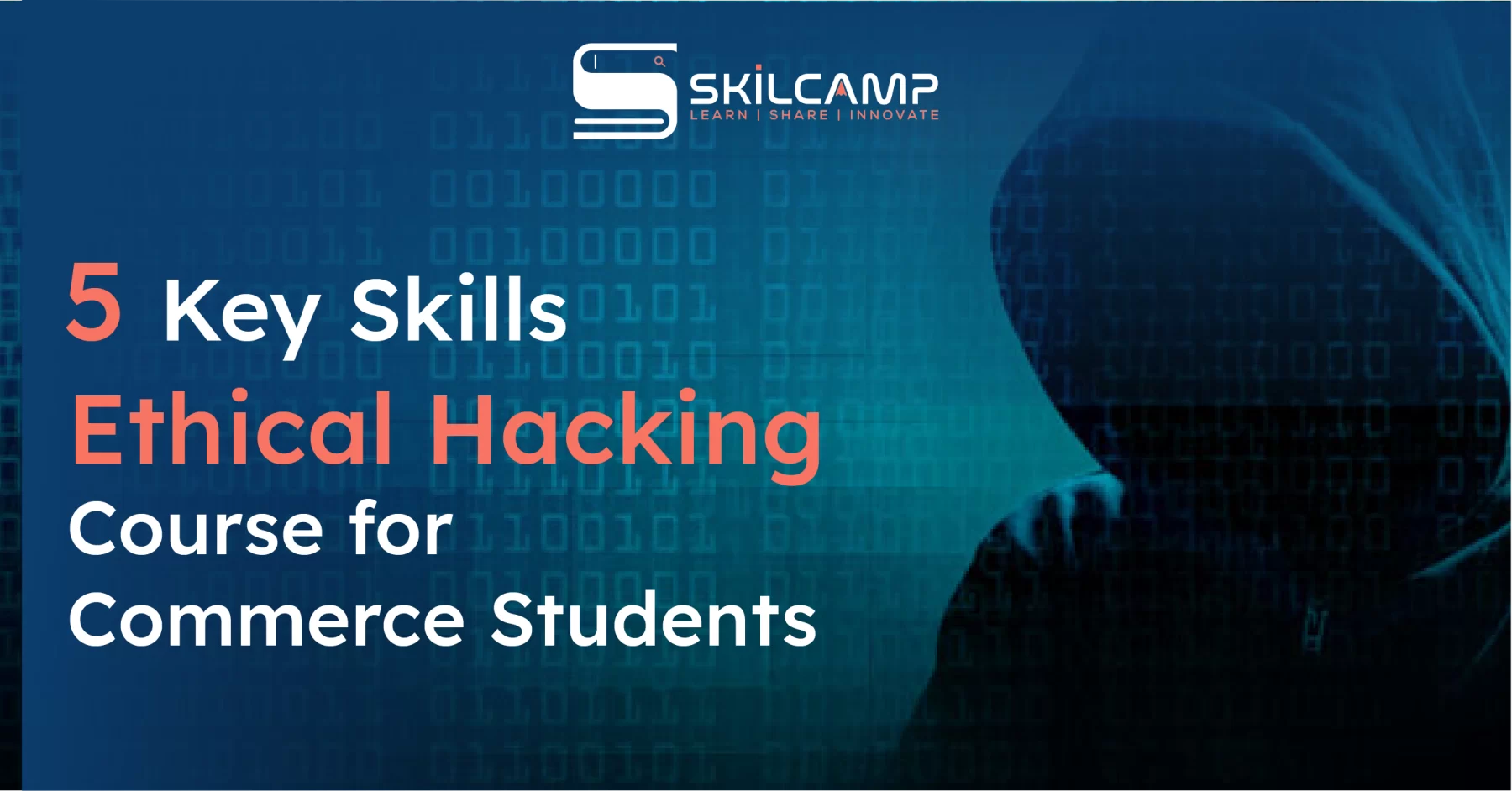


Leave a Reply